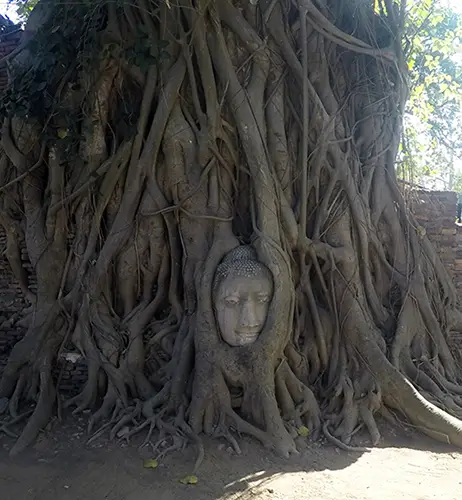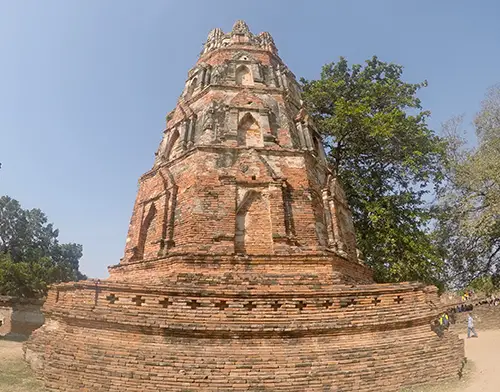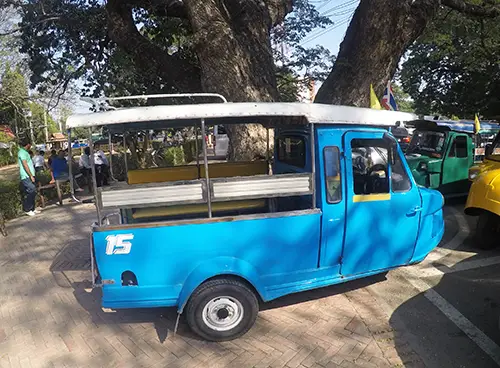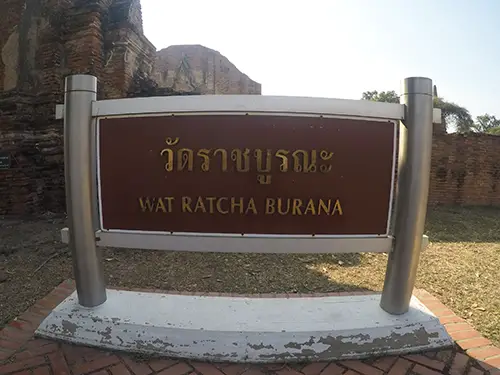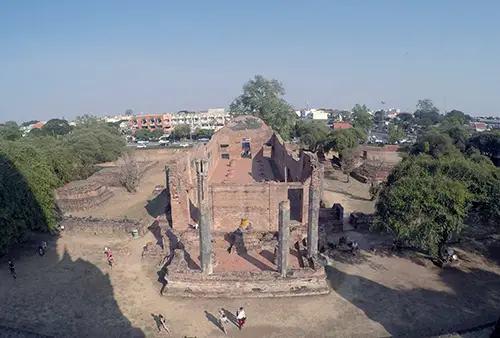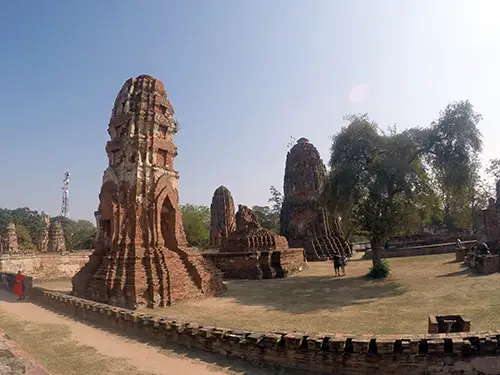Every year the rains come and go, the riverbanks overflow, the rice paddies get flooded, the rice grows and feeds us all and life goes on as planned. But then there are the years when the rains won’t stop “on time” and the overflow of rainwater will flood the cities lying along the rivers in the central plains of Thailand and entire cities, villages, local neighbourhoods, and century-old building structures will go under water. Destroyed.
No–one who has been in any way interested in Thailand for the past few years will ever forget the 2011 disastrous floods that lasted for months and destroyed not only crops but ruined businesses and properties. Among the buildings that felt the grudge of nature were the many temples of Ayutthaya which suffered incredible structural damage.
When the waters finally receded, the entire country helped out in a huge clean–up campaign and even some international foundations and organizations donated money to help renovate some of the damaged temples. In subsequent years, Ayutthaya was flooded again and again with various degrees of damages to its national and world heritage sites and the renovations are still an ongoing process.
So, it’s not a bad idea to set aside one day to revisit Ayutthaya and witness by yourself the progress made in returning the formal capital of Siam to its former glory. There are thousands of temples and ruins in Ayutthaya and to visit them all in just one day (or even one week) would be impossible, so when making your travel plans, you should narrow down your touristic objectives to be concise and precise.
I recommend starting with the two most central temple complexes of Wat Mahathat and Wat Rajaburana which were both on the front–page of all newspapers when the floods submerged them in water. Following that, it would be good to then travel to the outskirts of Ayutthaya to visit the Portuguese and the Japanese Villages which have both been “remodeled” to make up for the damages suffered four years ago.
Tons of Ayutthaya-style tuk tuks, plus fruit and souvenir vendors are stationed in the parking lot of Wat Mahathat. It is maybe the most famous destination in Ayutthaya due to its iconic Buddha head trapped in the roots of a banyan tree. When the floods reached the city centre, the water levels rose to the eye level of the local statue and water marks are still slightly visible on the tree and the surrounding red-brick wall.
This 14th century temple that was sacked by the invading Burmese army in 1767, bringing thus the fall of Ayutthaya as the capital of Siam, is now a well-kept complex. The only invaders to be seen these days are the hordes of tourists who come for a half-an hour stop by busloads before being ushered off to their next destination. Patience is thus required to get to the front of the line and take a picture of the Buddha head while, at the same time, dodging all the selfie sticks that poke out in every direction, which requires even more patience! The rest of the temple grounds are more peaceful and are definitely worth exploring, getting away from the masses.
Right next to Wat Mahathat is Wat Rajaburana, a royal temple built in 1424 which has, surprisingly, better survived both the invading armies and also the wrath of Mother Nature. The Royal Vihara, or the Assembly Hall, has all its walls still standing (no ceiling and roof though) with a decapitated Lord Buddha image at the back of the building. In their rush, the Burmese army had no time to take all the statues back to Burma but instead took only the Buddha heads (which were also cut down to see whether the statue was actually made of gold on the inside, or just clay throughout).
Although the red brick structures might seem very similar to those of the neighbouring temples at Wat Mahathat or any other ruins around Ayutthaya, it’s worth dedicating more time to the exploration of Wat Rajaburana because of its mysterious Parang, or main stupa. Actually, the ruin is presently undergoing structural reconditioning with the help of a German foundation who donated money to help strengthen the foundation of the stupa.
But why did this stupa receive such special attention and not one of the other hundreds of the other stupas which dot around throughout the city? The answer is simple: inside this Parang, researchers have discovered a secret chamber, a crypt, with highly ornate and detailed mural paintings. To reach this chamber you have to first climb half–way up the stupa and then go down a narrow flight of stairs deep inside the Parang.
There are two chambers, an upper one and a lower one, both displaying images of the Buddha and of high lords at the court of Ayutthaya. If you’re claustrophobic, then you’d better stop at the first section as the stairs to the lower level can only handle one person either way. The murals are clearly visible and are very much worth the excitement during the immense heat – together with extreme humidity – that one has to endure on the way down and back up.
Both temples have an entry fee of just 50 baht for foreigners, while Thai people get to go in for free. It closes at 5pm. The temples are very easy to find wherever you are in Ayutthaya. All you have to do is follow the signs. It’s highly recommended that you rent a bicycle from one of the many guesthouses and small hotels that rent them out and it is enjoyable to cycle around the city.
Your next two destinations will require a bit of effort to reach by bicycle, but in this method of transport, you’ll get to see the rest of the city in a detailed and close–up perspective. You’ll also have the choice of stopping whenever you want, to either take photos or explore some of the other temples you’ll encounter on your way.
The Portuguese Village and the Japanese Village that you should definitely not miss (re)visiting are situated exactly on the opposite sides of the Chao Phraya River. If you come from downtown, then your first stop will be at the Portuguese Village where you’ll be surprised to see that half of the open graveyard that contained tens of human remains is now gone. The 2011 floods mixed up all the bones and ruined the foundation of the graveyard. You’d better take loads of pictures during your visit – because who really knows what’s going to be left in just a few more years? Entry there is free.
To get to the Japanese Village you’ll have to cross the bridge on the other side of the river and, once again, follow the road signs. Nihonmachi, or the Japanese Village, once boasted a beautiful Japanese garden, an exhibition room, a souvenir shop and a museum/learning centre. The Japanese garden has been restored but not to its former glory, while the museum is still at the forefront of disseminating information about the Thai-Japanese relations. Entry is 50 baht for both Thais and foreigners.
From Bangkok, you can reach Ayutthaya by bus from Mo Chit Station, by train from Hua Lampong train station, or by minivan from Victory Monument. If you drive your own car, then Ayutthaya can be reached either taking the highway towards Don Muang airport or on the motorway to Suvarnabhumi Airport and Chonburi.
A shorter version of this article was initially published in Mango Metro (May 2015)
